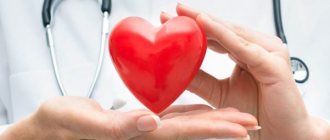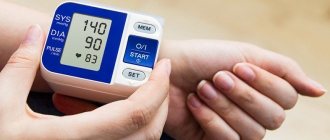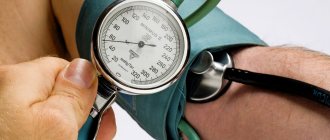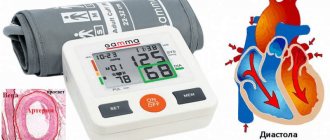From this article you will learn: why the upper pressure can simultaneously increase and the lower pressure decrease. What additional symptoms appear? What to do in this case, how can the disease be cured.
Author of the article: Victoria Stoyanova, category 2 doctor, head of the laboratory at the diagnostic and treatment center (2015–2016).
Article publication date: December 31, 2016
Article updated date: 05/25/2019
Systolic (upper) pressure should normally be 110–130 mmHg. Art. Diastolic (lower) – 70–80 mm Hg. Art. The difference between these two values is called pulse pressure (abbreviated as PP) - normally it is 30–40 mmHg. Art.
When the upper pressure increases and the lower pressure, on the contrary, decreases (above the indicated values), we can say that the patient has increased pulse pressure.
This may indicate various diseases of the cardiovascular or endocrine system. High pulse pressure must be dealt with through treatment of the underlying disease: some pathologies can be cured completely, others cannot. The therapy will be carried out by a cardiologist, angiologist or endocrinologist.
The concept of systolic and diastolic pressure
The period of time during which the heart pumps blood into the arteries is called systole. Therefore, the upper pressure is considered systolic. This causes the heart muscle to contract and the valve to open.
This is followed by a period of relaxation called diastole. At the same time, the heart is prepared to absorb a new portion of blood.
Optimal blood pressure readings are when systolic blood pressure is 120 and diastolic blood pressure is 80. This is considered an indicator of good health in a person. But under the influence of certain factors, changes may occur. If the pressure fluctuates within 30 mm. rt. Art., then this is not considered a pathology. In other cases, it is necessary to be examined and treated.
Reduced upper pressure
- 1 Normal indicators
- 2 How does low heart pressure manifest?
- 3 Causes of low heart pressure 3.1 Why is this condition dangerous?
- 4.1 Traditional medicine
Have you been struggling with HYPERTENSION for many years without success?
Head of the Institute: “You will be amazed at how easy it is to cure hypertension by taking it every day...
Read more "
To combat low blood pressure, many drink coffee, but the effect of the drink does not last long. We need to understand the reasons. Low upper pressure is less dangerous than high pressure, but it still causes discomfort. For example, with low blood pressure, you often feel dizziness, darkening of the eyes, and sometimes loss of consciousness. It is impossible to define a separate group of people suffering from hypotension, since the condition can develop in a person of any age.
Normal indicators
Blood pressure is the force with which blood presses on blood vessels during heart contractions.
It is measured with a tonometer. If the upper pressure of the device shows 120, and the lower 80, then everything is normal. But many experts argue that these indicators are different for everyone. Some people, having a blood pressure below 115/75, feel great, while for others this blood pressure reading is low. If the numbers fluctuate in one direction or the other, malfunctions in the functioning of internal organs are suspected. Often, blood pressure is controlled by the pulse, respiratory system and heart. The level of blood pressure depends on heart contractions, the elasticity of blood vessels, and the amount of blood involved in the blood circulation process. on
There are 2 numbers, tonometer indicators, upper and lower:
- The process of the heart pushing blood into the aorta means systolic pressure. Normal is 120 mmHg. Art. The upper number depends on the force with which the heart contracts, the resistance of the vessel walls and the number of contractions.
- The process of blood returning to the heart is called diastolic blood pressure - the lower number. The norm is 80 mm Hg. Art.
There are several types of low blood pressure:
- drop in blood pressure when standing up - orthostatic hypotension;
- hypotension after eating - postprandial low blood pressure;
- vegetative-vascular hypotension - after standing for a long time, especially in the summer heat.
Return to contents
How does low heart pressure manifest?
A decrease in upper pressure provokes weakness of the entire body.
If blood pressure is low, you feel worse, you feel lost in space, with sudden movements you feel dizzy and weak, and causeless anxiety appears. This is because people suffering from low heart pressure are dependent on the weather and react to the smallest changes in atmospheric pressure. The pressure is also low when staying in steam rooms for a long time. Traveling in stuffy buses can cause fainting. Trouble sleeping at night is also a sign of hypotension. After waking up, you feel tired, during the day you feel a strong desire to sleep, and a general state of irritability. The cause is a decrease in vascular tone - circulation slows down, organs are not saturated with oxygen. With hypotension, the usual tonometer readings drop by 20% or more, systolic pressure with normal lower pressure may be below 90 mm.
Return to contents
Causes of low heart pressure
- Improper functioning of the heart. Heart failure, bradycardia, arrhythmia, tachycardia, and complications with the heart valves occur.
- Endocrine system disorders. Hypoglycemia, hypothyroidism, adrenal insufficiency, sometimes diabetes.
- Insufficient amount of fluid in the body due to physical activity, diarrhea.
- Severe injuries to the body, resulting in severe blood loss.
- The first 3 months of pregnancy can lower the tonometer readings by 10–20 units.
- Overwork.
- Acclimatization of the body.
If the systolic pressure is 60 mm Hg. the patient may lose touch with reality, the legs will feel like “wool”, clouding may occur, after which fainting may occur. It is important that someone is nearby to provide first aid, otherwise everything could end badly. There are many ways to lower blood pressure. But, if suddenly there is no one nearby, you need to at least have time to call an ambulance.
Return to contents
Why is this condition dangerous?
Critically low blood pressure can cause loss of consciousness.
Why do you feed pharmacies if hypertension is afraid of the usual like fire...
Tabakov has revealed a unique remedy against hypertension! To reduce blood pressure while preserving blood vessels, add to…
In general, low blood pressure is not very dangerous; with hypotension, the risk of kidney disease and the occurrence of stroke decreases. The danger is that when someone faints, they can suffer various injuries. This is especially dangerous for pregnant women, since falling to the ground can damage the stomach and cause a miscarriage.
Systolic pressure is considered critical at upper values from 40 to 60 mm Hg. Art. When the patient is unconscious for more than 7–8 minutes. death comes. The heart rate drops to a minimum (about 45 beats per minute). In such cases, it is necessary to call an ambulance.
Return to contents
What to do when treating low upper blood pressure?
Treatment for hypotension does not require multiple medications. After the doctor has ruled out serious diseases, the specialist adjusts the patient’s lifestyle: diet, rest and physical activity, it is also useful to take a contrast shower, hardening will also not harm. First of all, you need a healthy sleep of at least 8 hours, and after sleep it is not advisable to get up suddenly, you need to do exercises in the morning, eat less unhealthy food. Among the means of physiotherapy, the following can be prescribed: magnetic therapy, cryotherapy, reflexology, massage. Such procedures improve blood circulation in the vessels and pressure, under normal conditions, will not fall. As for medications, medications containing caffeine are prescribed.
Return to contents
ethnoscience
Traditional healers recommend the following recipes for lowering the upper limit of blood pressure:
- Radiola tincture 20–25 drops.
- 2 tablets of green tea extract + 0.5 g of ascorbic acid.
- "Pantocrine" 25-30 drops. + 10–15 drops Manchu Aralia.
- Ginseng tincture 30-35 drops. in a glass of grape juice.
- If your blood pressure drops in the morning, Cordiamin 25-30 drops. + 1 tsp. tinctures of Chinese lemongrass.
To provide quick help and prevent the condition from worsening, an integrated approach is recommended, which involves the use of medications with natural tinctures. Strong black tea and coffee can quickly increase blood pressure. For long-term treatment, infusions of herbs are suitable - yarrow, tansy, immortelle, steelweed. Another mixture that is also effective is ginseng with Rhodiola or Eleutherococcus.
on
A comment
Nickname
Pulse indicator
The difference between systolic and diastolic blood pressure is called the pulse rate. If a person’s blood pressure is 120/80, then the pulse pressure readings will be 40. This difference is taken into account when diagnosing cardiac pathologies.
What is considered a deviation
If the difference between the upper and lower blood pressure is large, it means that there are disturbances in the functioning of the cardiovascular system. Having determined this indicator, you can:
- find out what condition the vascular bed is in;
- detect the degree of its patency;
- find out the condition of the artery walls;
- identify whether there are foci of inflammation or stenosis.
Using blood pressure and pulse pressure indicators, we can predict the nature of the developing pathology.
Diagnostic methods
A large difference in systolic and diastolic blood pressure is a sure sign of pathologies of an endocrine or cardiovascular nature. If a patient has a stable increase in upper pressure and low lower pressure, he is prescribed the following types of studies:
- Electrocardiogram;
- General and detailed laboratory blood tests;
- Hormone test;
- Ultrasound examination of the heart;
- Tests to determine cholesterol and blood glucose levels;
- Pressure monitoring using the Holter method.
Based on the results of the general examination, the patient is sent for additional diagnostics to a cardiologist or a specialist - endocrinologist.
Holter monitoring monitors heart function throughout the day
Reasons for the large difference between the indicators
A pressure gap, in which systolic blood pressure increases and diastolic blood pressure decreases, is observed in a certain group of patients. In most cases, disorders occur due to age-related changes in the body. It is in older people that this form of hypertension is most often observed. It can be caused by:
- suffered a heart attack;
- post-stroke condition;
- decreased elasticity of blood vessels;
- heart failure;
- atherosclerosis of the aorta and other disorders of the heart and kidneys.
The problem arises as a result of increased stiffness of the small vessels of organs and tissues.
This causes blood flow to slow down. The walls of blood vessels become inelastic due to the development of atherosclerosis. This occurs with diabetes mellitus, thyroid dysfunction and other pathological processes. With this type of hypertension, the circadian rhythm of blood pressure is disrupted. There are cases when systolic blood pressure is elevated, but the dystonic indicator remains normal.
Blood pressure readings most often change in the morning and at night. This is accompanied by a feeling of weakness. If this problem occurs, you should urgently consult a doctor, as this indicates the development of serious pathologies.
What is the danger of a large pulse difference?
Such a pathological condition threatens to deteriorate a person’s general well-being and reduce the quality of life. If the diastolic and systolic indicators change simultaneously, this is the worst case scenario. Constantly recorded extremely high upper pressure is a harbinger of a heart attack or stroke.
A large pulse difference can only be caused by a decrease in lower pressure, which indicates myocardial weakness, myopathy, cardiodilation, and loss of elasticity of the great vessels.
The pulse difference that accompanies isolated arterial hypertension (ISAH) indicates emerging complications of the heart, blood vessels, kidney disease, and atherosclerosis.
Symptoms
In the early stages, the pathology has no manifestations. Gradually the patient begins to notice the appearance of:
- Chronic fatigue.
- Increased heart rate and increased pulse.
- Chills and increased sweating.
- Increased irritability.
- Headache.
- Causeless anxiety.
- Sensations of pulsation in the head.
- Deterioration of memory and attention.
- Sleep disorders.
Although such problems are observed mainly in older people, sometimes young people also suffer from this. Most often, the symptoms are ignored and attributed to ordinary fatigue. Therefore, first of all, you need to measure your blood pressure. If blood pressure readings do not exceed the permissible values, then this means fatigue. In case of other developments, it is necessary to consult a doctor, since violations are dangerous for the development of complications.
How to raise blood pressure
The first thing to do if your blood pressure is too low is to call an ambulance. Next, it is recommended to take a horizontal position and raise your legs to an angle of 30 0.
After this, massage the neck area, which will increase blood flow to the head. Even if you improve, you should not get up suddenly.
The fastest way to raise blood pressure is to drink a cup of strong coffee. The indicator in this case increases by 10 points on average. This method is considered not dangerous for the lower value, since its rise in this case does not occur.
What to do at home
If an attack of increased systolic and decreased diastolic pressure occurs, you must:
- Lie down on the bed.
- Try to calm down and not be nervous.
- Take medicine. Medicines to improve blood flow and lower blood pressure can help make you feel better. You can take an Aspirin tablet; taking other medications should be discussed with your doctor.
- Avoid heavy loads.
The patient should stay in bed and avoid any overexertion. After providing first aid, you must call a doctor.
Folk remedies
If the upper pressure is low, traditional medicine knows what to do. If you notice a deterioration in your health due to a decrease in blood pressure, it is recommended to drink a cup of hot hibiscus tea. This drink will slightly increase blood pressure, but not so much as to cause symptoms characteristic of hypertension.
Among decoctions of medicinal herbs, it is recommended to pay attention to lemongrass leaves, tansy and St. John's wort. These plants increase vascular tone, thereby reducing the symptoms of hypotension and low upper pressure. To prepare the decoction, boil 2 large spoons of plant material in 500 ml of water for 10 minutes. Then the medicine is infused for an hour, filtered and taken three times a day, 100 ml. The course of treatment with medicinal herbs takes two weeks.
Fresh pomegranate juice will help improve your well-being. It is recommended to drink one glass daily for the treatment and prevention of lowering blood pressure. Orange juice increases vascular tone and protects the cardiovascular system from age-related changes, so it should also be used for treatment.
Fresh juices are good for blood vessels
Medicines
Taking medications is an important part of treatment. Reducing the increased rate is achieved with the help of:
- Diuretics. These drugs remove excess fluid from the body and reduce the load on the heart, thereby reducing the risk of complications.
- Beta blockers. They are usually recommended for people who have had a heart attack. But they cannot be used in the presence of diabetes mellitus and dysfunction of the respiratory system.
- Calcium ion antagonists. Treatment is usually carried out with Isradipine or Nifedipine retard.
- Adenosine triphosphate inhibitors. They help restore the functioning of the nervous system and improve brain function.
During the treatment process, it is important to remember that you need to reduce blood pressure gradually. A sharp decrease can cause brain or kidney failure. Therefore, the listed and any other drugs should be prescribed by a doctor after a comprehensive examination and confirmation of the diagnosis.
Lifestyle and diet
Non-drug ways to treat low blood pressure include lifestyle and diet adjustments. If you have low blood pressure, it is recommended to eat foods rich in sodium. You must include in your diet:
- pickles, especially sauerkraut;
- sea fish and other seafood;
- seaweed;
- spices;
- chocolate and cocoa;
- offal;
- fresh fruits and vegetables.
There are no special restrictions on the foods consumed, but it is important to increase the consumption of salt and clean water. As for drinks, you should give preference to green tea. It does not have a direct effect on blood pressure, but normalizes cardiac activity and the functioning of the nervous system.
Since a decrease in blood pressure is directly related to the functioning of the nervous system, it is necessary to change your lifestyle in such a way as to avoid stress, overwork and psycho-emotional stress. Healthy sleep plays an important role in treatment. If your blood pressure is low, it is recommended to go to bed around 10 pm and wake up at 6-7 am. This schedule is considered optimal for the normal functioning of the nervous system.
Before going to bed, you need to take daily walks for 20-30 minutes. This will saturate the body with oxygen, relieve nervous tension and have a positive effect on the quality of sleep.
You should definitely play sports. Preference is given to those types of physical activity that improve the functioning of the nervous system - yoga, swimming in the pool and breathing exercises.
In some cases, lifestyle changes are enough to normalize blood pressure without the use of medications. To avoid the development of negative consequences, you should measure your blood pressure daily with a home tonometer and regularly be examined by a cardiologist and neurologist.
From this article you will learn: why the upper pressure can simultaneously increase and the lower pressure decrease. What additional symptoms appear? What to do in this case, how can the disease be cured.
Author of the article: Victoria Stoyanova, doctor of the 2nd category, head of the laboratory at the diagnostic and treatment center (2015–2016).
Systolic (upper) pressure should normally be 110–130 mmHg. Art. Diastolic (lower) – 70–80 mm Hg. Art. The difference between these two values is called pulse pressure (abbreviated as PP) - normally it is 30–40 mmHg. Art.
When the upper pressure increases and the lower pressure, on the contrary, decreases (above the indicated values), we can say that the patient has increased pulse pressure.
This may indicate various diseases of the cardiovascular or endocrine system. High pulse pressure must be dealt with through treatment of the underlying disease: some pathologies can be cured completely, others cannot. The therapy will be carried out by a cardiologist, angiologist or endocrinologist.
Lifestyle
In addition to taking medications prescribed by the doctor, the patient must make certain lifestyle changes. The patient needs to adhere to several simple recommendations that will have a positive effect on the condition of the body:
- Limit salt intake. The body of people with similar problems is highly salt sensitive. Excessive consumption of sodium chloride negatively affects the condition of blood vessels. Therefore, by eliminating this factor, it is possible to achieve normalization of blood pressure.
- Avoid foods high in cholesterol.
- Get rid of excess weight. To do this you need to increase physical activity. Additional loads must be introduced gradually. This will stabilize the indicators.
- Avoid bad habits, especially smoking.
All these measures will significantly speed up the healing process. With their help, you can avoid the development of heart pathologies. kidneys, visual impairment and other complications.
Prevention measures
The fight against hypertension is a rather long and complex process. The disease cannot be completely eliminated. With the help of medications and a healthy lifestyle, you can keep the indicators within normal limits.
The main measures to prevent hypertension are maintaining weight within normal limits and a healthy lifestyle. You can avoid the development of such violations if:
- stop smoking;
- reduce alcohol consumption;
- eat right, eat only healthy foods;
- maintain the required level of physical activity;
- take regular walks in the fresh air;
- avoid stress and emotional overstrain.
Thanks to these tips, you can not only avoid changes in blood pressure, but also significantly improve the condition of the entire body.











